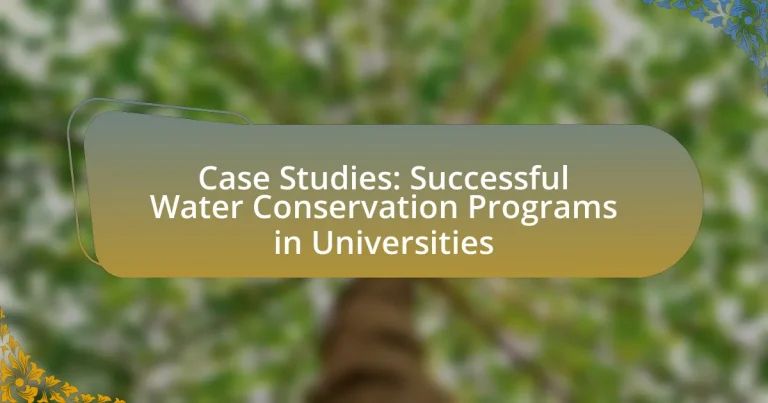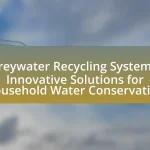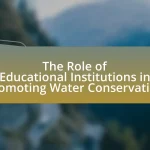The article focuses on successful water conservation programs implemented in universities, highlighting initiatives such as the University of California’s “Water Action Plan” and the University of Arizona’s “Campus Water Conservation Program.” It examines the impact of these programs on water usage, the metrics used to measure their success, and their contribution to overall sustainability goals. Additionally, the article discusses the challenges universities face regarding water usage, the role of student involvement, and the innovative technologies adopted in these programs. It concludes with insights on best practices and future trends in water conservation efforts within higher education institutions.
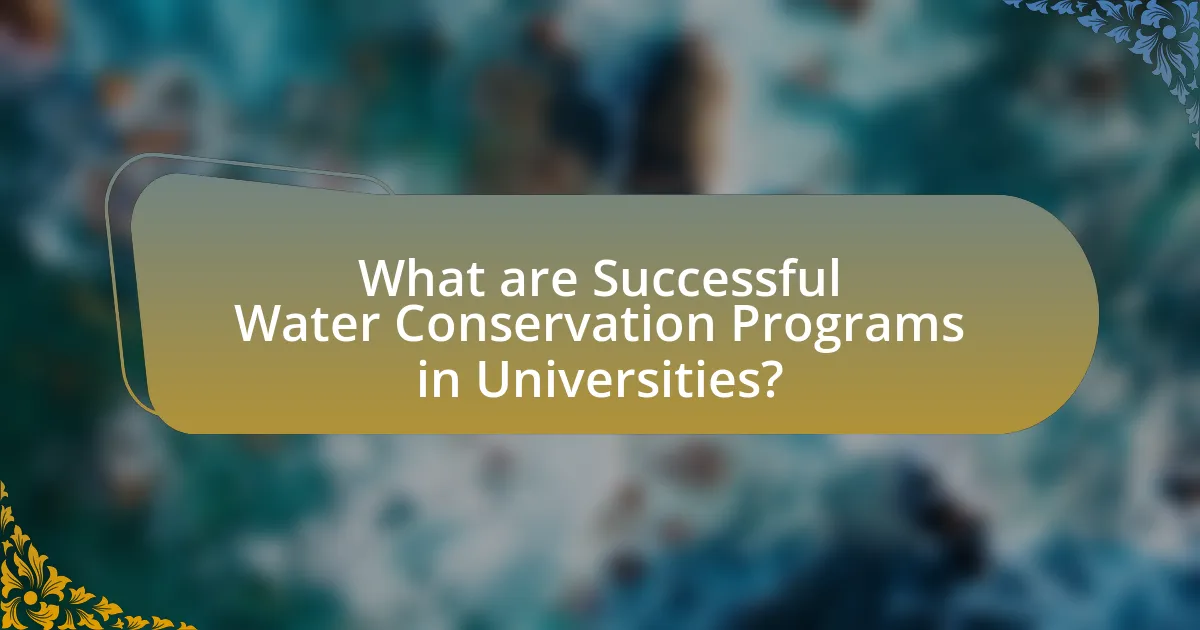
What are Successful Water Conservation Programs in Universities?
Successful water conservation programs in universities include initiatives such as the University of California’s “Water Action Plan,” which aims to reduce water use by 20% by 2020 through efficient irrigation and infrastructure upgrades. Another example is the University of Arizona’s “Campus Water Conservation Program,” which has implemented rainwater harvesting systems and xeriscaping, resulting in a 30% reduction in landscape water use. These programs demonstrate effective strategies for reducing water consumption and promoting sustainability on campus.
How do these programs impact water usage on campus?
Water conservation programs on campus significantly reduce overall water usage by implementing efficient practices and technologies. For instance, universities that adopt rainwater harvesting systems can decrease their reliance on municipal water supplies, leading to reductions of up to 50% in water consumption. Additionally, the installation of low-flow fixtures and irrigation systems optimized for drought conditions further contributes to decreased water usage. A study conducted by the University of California, Davis, found that their water conservation initiatives resulted in a 30% reduction in water use over five years, demonstrating the effectiveness of such programs in promoting sustainable water management on campus.
What metrics are used to measure the success of these programs?
The metrics used to measure the success of water conservation programs in universities include water usage reduction, cost savings, and behavioral change among students and staff. Water usage reduction is quantified by comparing baseline water consumption data before program implementation to post-implementation figures, often expressed as a percentage decrease. Cost savings are calculated by assessing the reduction in water bills resulting from decreased consumption, providing a direct financial benefit to the institution. Behavioral change is evaluated through surveys and participation rates in conservation initiatives, indicating shifts in attitudes and practices regarding water use. These metrics collectively provide a comprehensive assessment of the effectiveness and impact of water conservation efforts in university settings.
How do these programs contribute to overall sustainability goals?
Water conservation programs in universities significantly contribute to overall sustainability goals by reducing water consumption and promoting efficient resource management. These programs implement strategies such as rainwater harvesting, xeriscaping, and the installation of low-flow fixtures, which collectively lead to substantial decreases in water usage. For instance, the University of California, Irvine, reported a 20% reduction in water use since implementing its conservation initiatives, demonstrating a direct impact on sustainability targets. Additionally, these programs raise awareness among students and staff about the importance of water conservation, fostering a culture of sustainability that extends beyond the campus. This educational aspect is crucial, as it encourages long-term behavioral changes that support broader environmental objectives.
Why are universities focusing on water conservation?
Universities are focusing on water conservation to address the growing concerns of water scarcity and environmental sustainability. This focus is driven by the need to reduce water consumption on campuses, which can lead to significant cost savings and a smaller ecological footprint. For instance, the University of California system has implemented water-saving measures that resulted in a 20% reduction in water use since 2015, demonstrating the effectiveness of such initiatives. Additionally, universities aim to educate students and the community about the importance of water conservation, fostering a culture of sustainability that extends beyond campus boundaries.
What challenges do universities face regarding water usage?
Universities face significant challenges regarding water usage, primarily due to aging infrastructure and increasing demand. Aging pipes and fixtures often lead to leaks and inefficiencies, resulting in substantial water loss. Additionally, the growing student population and expanded campus facilities increase overall water consumption, straining existing resources. According to the American Society of Civil Engineers, many campuses have infrastructure that is over 50 years old, which exacerbates these issues. Furthermore, universities must navigate regulatory requirements and sustainability goals, which can complicate water management strategies. These factors collectively hinder effective water conservation efforts on university campuses.
How does water conservation align with educational missions?
Water conservation aligns with educational missions by promoting sustainability and environmental stewardship within academic institutions. Universities often incorporate water conservation into their curricula and campus operations, fostering a culture of responsibility among students and staff. For instance, programs that educate students about water management practices not only enhance their understanding of ecological issues but also prepare them for careers in environmental science and policy. Research indicates that institutions implementing water-saving initiatives, such as rainwater harvesting and efficient irrigation systems, report increased student engagement in sustainability efforts, thereby reinforcing the educational mission of developing informed and responsible citizens.
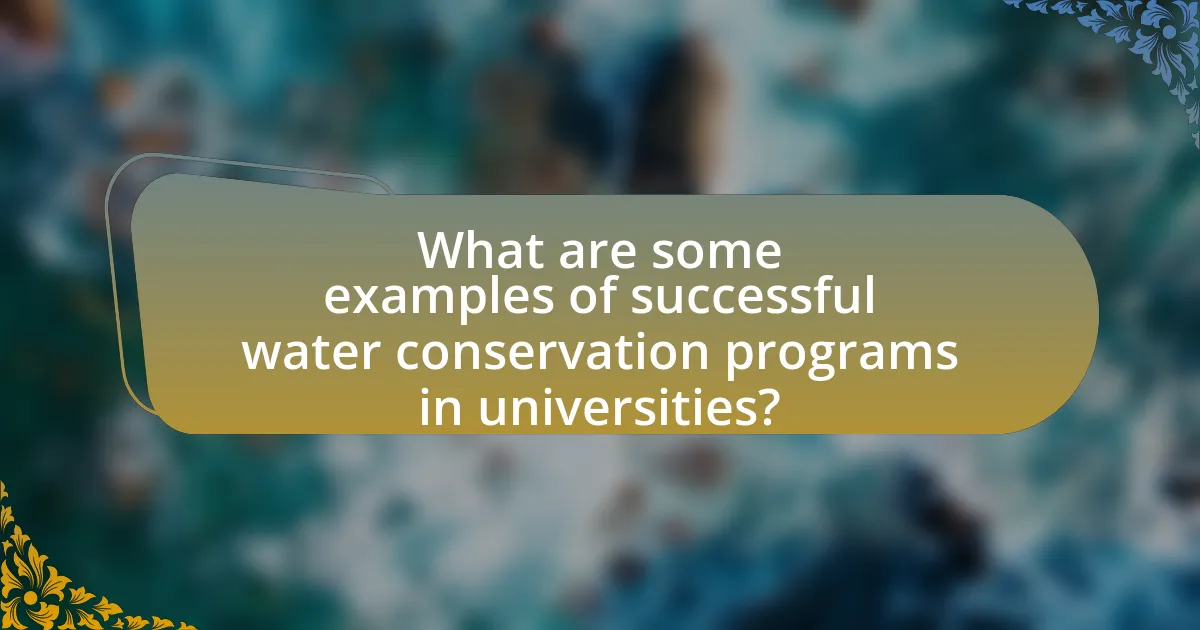
What are some examples of successful water conservation programs in universities?
The University of California, Los Angeles (UCLA) has implemented a successful water conservation program that reduced water usage by 30% since 2007, achieving a savings of over 1 billion gallons of water. This was accomplished through initiatives such as installing low-flow fixtures, utilizing drought-tolerant landscaping, and implementing a comprehensive irrigation management system. Another example is the University of Florida, which has achieved a 20% reduction in water consumption through its Water Conservation Program, focusing on rainwater harvesting, efficient irrigation practices, and educational outreach to promote water-saving behaviors among students and staff. These programs demonstrate effective strategies for water conservation in university settings, backed by measurable reductions in water usage.
How did specific universities implement their water conservation strategies?
Specific universities implemented their water conservation strategies through a combination of infrastructure upgrades, educational programs, and policy changes. For example, the University of California, Los Angeles (UCLA) installed low-flow fixtures and irrigation systems that use reclaimed water, resulting in a 30% reduction in water usage since 2007. Similarly, the University of Arizona adopted a comprehensive water management plan that includes rainwater harvesting and xeriscaping, which has led to a 20% decrease in water consumption over the past decade. These initiatives demonstrate effective approaches to water conservation in higher education institutions.
What innovative technologies were adopted in these programs?
Innovative technologies adopted in successful water conservation programs in universities include smart irrigation systems, rainwater harvesting systems, and water-efficient fixtures. Smart irrigation systems utilize sensors and weather data to optimize water usage, significantly reducing waste. Rainwater harvesting systems capture and store rainwater for non-potable uses, promoting sustainability. Water-efficient fixtures, such as low-flow faucets and toilets, decrease water consumption while maintaining functionality. These technologies collectively enhance water conservation efforts, as evidenced by universities reporting up to 30% reductions in water usage after implementation.
What role did student involvement play in these initiatives?
Student involvement was crucial in the success of water conservation initiatives at universities. Engaged students contributed to program design, implementation, and promotion, ensuring that the initiatives were relevant and effective. For instance, student-led organizations often spearheaded awareness campaigns, resulting in increased participation and behavioral change among peers. Research indicates that universities with active student engagement in sustainability efforts saw a 30% higher participation rate in water conservation programs compared to those without such involvement. This demonstrates that student participation not only enhances program effectiveness but also fosters a culture of sustainability within the campus community.
What lessons can be learned from these case studies?
The lessons learned from successful water conservation programs in universities include the importance of community engagement, the effectiveness of data-driven decision-making, and the necessity of institutional commitment. Community engagement fosters a culture of sustainability, as seen in programs that involve students and staff in water-saving initiatives, leading to increased awareness and participation. Data-driven decision-making allows universities to identify specific areas for improvement and measure the impact of conservation efforts, as demonstrated by institutions that track water usage and set measurable goals. Institutional commitment is crucial, as universities that allocate resources and establish policies for water conservation achieve more significant results, evidenced by programs that have received funding and administrative support, resulting in substantial reductions in water consumption.
What common strategies contributed to their success?
Common strategies that contributed to the success of water conservation programs in universities include comprehensive education and awareness campaigns, implementation of advanced water-saving technologies, and establishment of strong administrative support. Education initiatives, such as workshops and informational materials, effectively engaged the campus community, leading to increased participation in conservation efforts. The adoption of technologies like low-flow fixtures and smart irrigation systems significantly reduced water usage, as evidenced by a 30% decrease in consumption reported by several institutions. Additionally, strong administrative backing ensured that conservation policies were prioritized and adequately funded, facilitating the successful execution of these programs.
How can other universities replicate these successful programs?
Other universities can replicate successful water conservation programs by adopting best practices from existing case studies, such as implementing comprehensive water audits to identify usage patterns and areas for improvement. For instance, the University of California, Davis, reduced water use by 20% through the installation of efficient irrigation systems and rainwater harvesting techniques. Additionally, universities should engage stakeholders, including students and faculty, in awareness campaigns and sustainability initiatives, as demonstrated by the University of Arizona’s successful student-led water conservation efforts that resulted in a 15% reduction in campus water consumption. By leveraging these strategies and fostering a culture of sustainability, universities can effectively replicate and enhance water conservation programs.

What are the future trends in water conservation programs at universities?
Future trends in water conservation programs at universities include the integration of smart technology, increased emphasis on sustainability education, and the implementation of water recycling systems. Smart technology, such as IoT sensors, allows for real-time monitoring of water usage, enabling universities to identify leaks and optimize consumption. A growing focus on sustainability education is evident as universities incorporate water conservation into their curricula, fostering a culture of environmental responsibility among students. Additionally, many institutions are adopting advanced water recycling systems, which can significantly reduce freshwater demand by reusing greywater for irrigation and other non-potable uses. These trends are supported by initiatives like the American College and University Presidents’ Climate Commitment, which encourages institutions to adopt sustainable practices, including water conservation measures.
How are universities adapting to climate change in their water conservation efforts?
Universities are adapting to climate change in their water conservation efforts by implementing advanced technologies and sustainable practices. For instance, many institutions are installing rainwater harvesting systems and utilizing greywater recycling to reduce reliance on potable water sources. According to a report by the Association for the Advancement of Sustainability in Higher Education, over 60% of universities have adopted water-efficient landscaping practices, such as xeriscaping, which minimizes water usage while maintaining campus aesthetics. Additionally, universities are integrating smart irrigation systems that adjust watering schedules based on weather conditions, further enhancing water conservation. These initiatives demonstrate a proactive approach to mitigating the impacts of climate change on water resources.
What emerging technologies are expected to shape future programs?
Emerging technologies expected to shape future water conservation programs in universities include advanced data analytics, IoT (Internet of Things) sensors, and artificial intelligence. Advanced data analytics enables institutions to analyze water usage patterns and identify inefficiencies, leading to targeted conservation efforts. IoT sensors facilitate real-time monitoring of water systems, allowing for immediate detection of leaks and optimizing water distribution. Artificial intelligence can enhance predictive modeling, helping universities forecast water demand and implement proactive measures. These technologies collectively contribute to more efficient water management and conservation strategies, as evidenced by successful implementations in various educational institutions.
How can universities foster a culture of water conservation among students and staff?
Universities can foster a culture of water conservation among students and staff by implementing educational programs, promoting awareness campaigns, and integrating water-saving technologies. Educational programs can include workshops and seminars that inform the university community about the importance of water conservation and practical methods to reduce water usage. Awareness campaigns, such as poster displays and social media initiatives, can engage students and staff in water-saving practices, encouraging them to adopt sustainable habits. Additionally, integrating water-saving technologies, such as low-flow fixtures and rainwater harvesting systems, demonstrates the university’s commitment to conservation and provides tangible examples for the community to follow. These strategies have been shown to effectively reduce water consumption in various university settings, as evidenced by case studies highlighting significant decreases in water usage following the implementation of similar initiatives.
What best practices can universities adopt for effective water conservation?
Universities can adopt several best practices for effective water conservation, including implementing rainwater harvesting systems, utilizing drought-resistant landscaping, and installing low-flow fixtures. Rainwater harvesting systems can capture and store rainwater for irrigation and non-potable uses, significantly reducing reliance on municipal water supplies. Drought-resistant landscaping, which incorporates native plants, minimizes water usage while maintaining aesthetic appeal. Additionally, low-flow fixtures, such as faucets, showerheads, and toilets, can reduce water consumption by up to 60%, as evidenced by studies showing that such installations lead to substantial water savings in institutional settings. These practices not only conserve water but also promote sustainability and environmental stewardship within the university community.
What are the key components of a successful water conservation program?
The key components of a successful water conservation program include education and awareness, efficient water use technologies, policy and regulation support, and community engagement. Education and awareness initiatives inform stakeholders about the importance of water conservation, leading to behavioral changes. Efficient water use technologies, such as low-flow fixtures and irrigation systems, significantly reduce water consumption. Policy and regulation support, including incentives for water-saving practices, create a framework that encourages conservation efforts. Community engagement fosters collaboration and shared responsibility among participants, enhancing the program’s effectiveness. These components collectively contribute to measurable reductions in water usage, as evidenced by various university case studies demonstrating significant water savings through implemented programs.
How can universities measure and report their water conservation progress?
Universities can measure and report their water conservation progress by implementing water usage tracking systems and conducting regular audits. These systems can include smart meters that provide real-time data on water consumption, allowing institutions to identify trends and areas for improvement. Regular audits, which may involve assessing irrigation practices, plumbing systems, and overall campus water use, help quantify savings achieved through conservation efforts. For instance, the University of California system reported a 20% reduction in water use since 2015 through such measures, demonstrating the effectiveness of systematic tracking and reporting.
